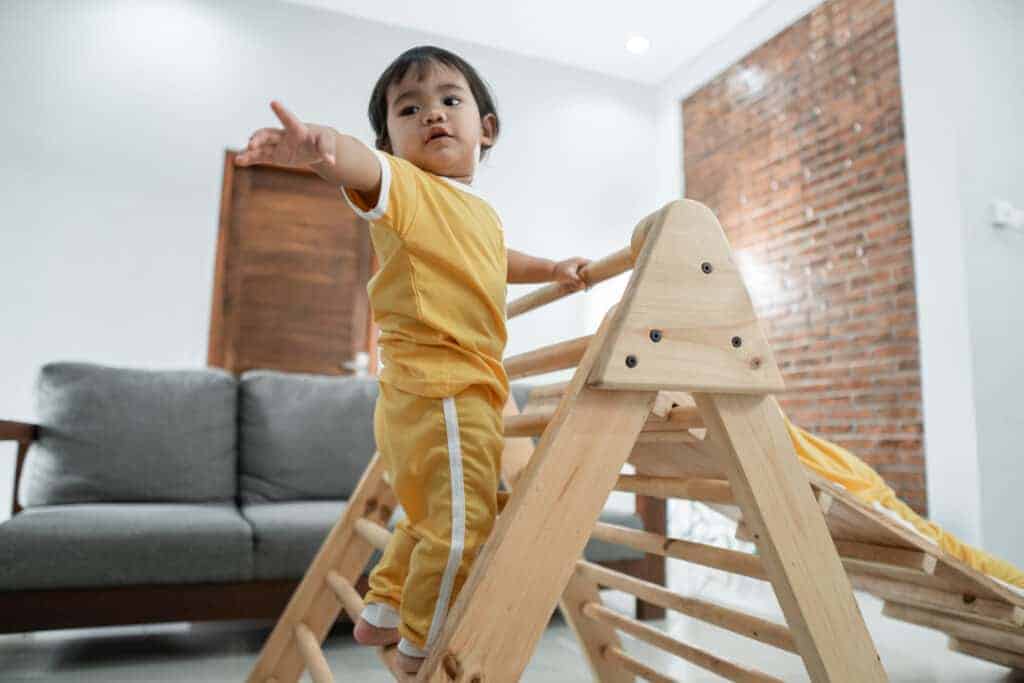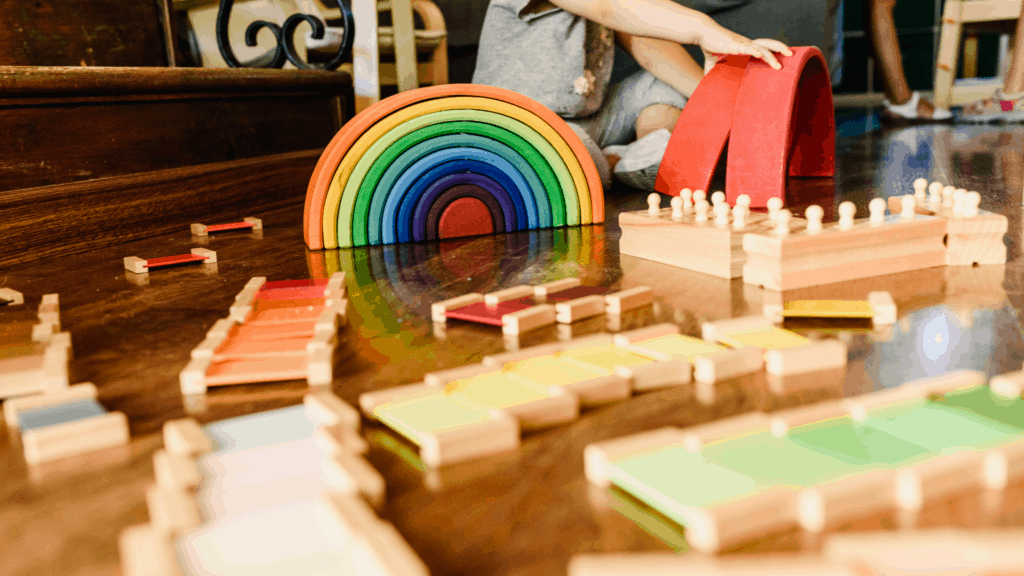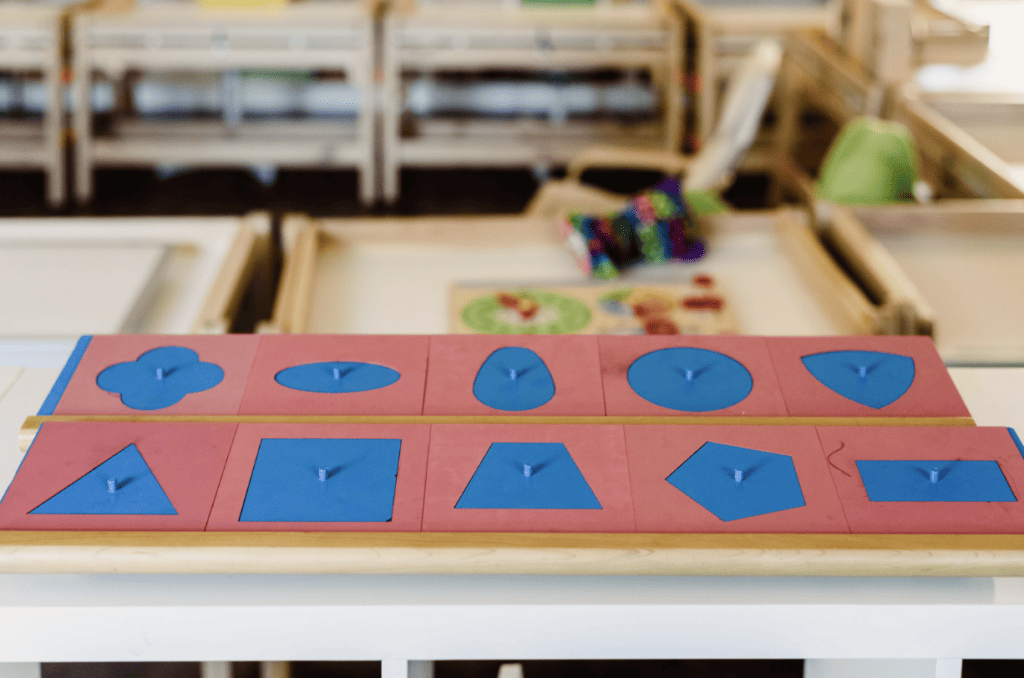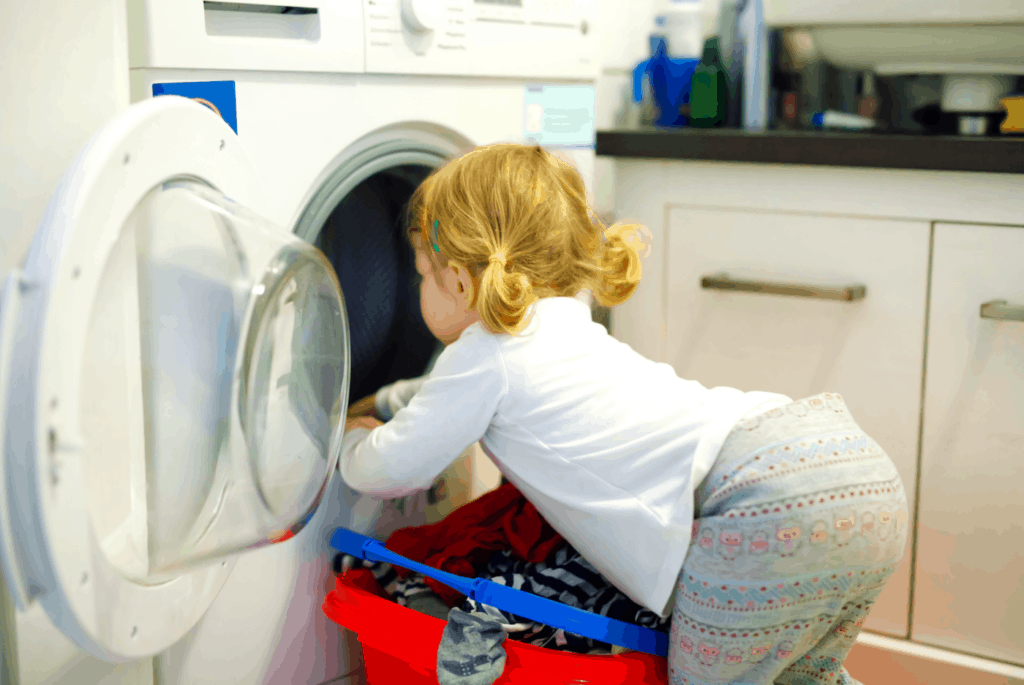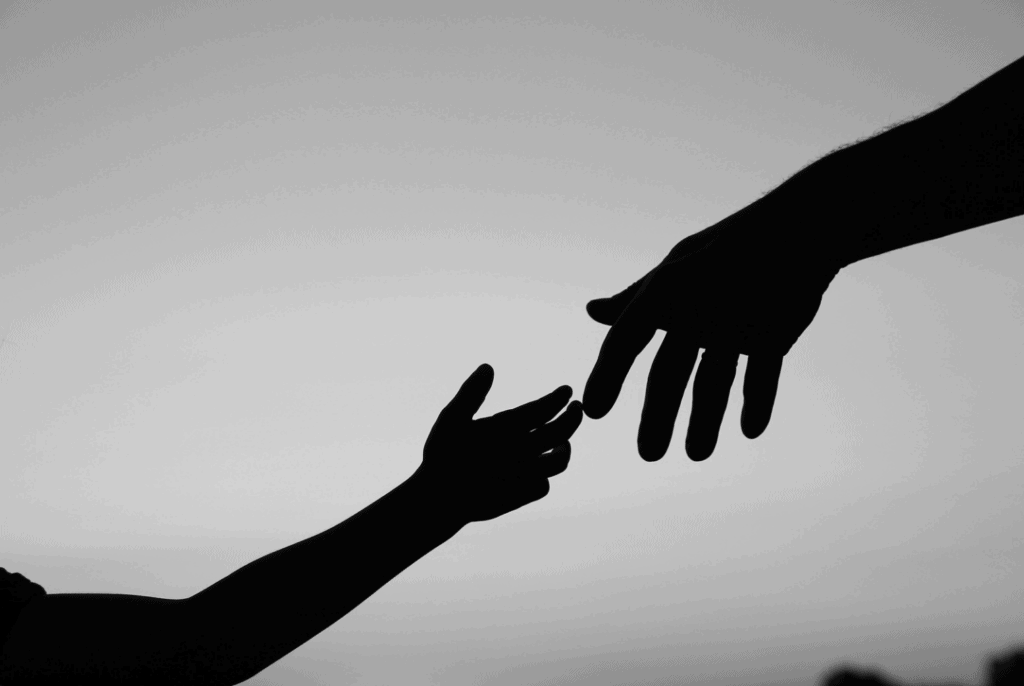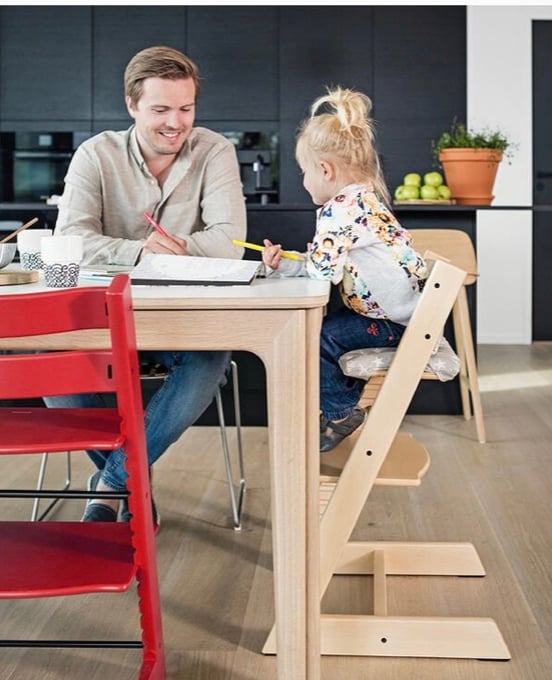Montessori for Today picks out furniture, educational tools, toys and lifestyle items that we think are the best and most exciting, based on independent research and careful consideration. On some occasions we earn revenue (at no additional cost to you) if you click the links and buy the products. But this doesn’t affect what we choose to highlight and we will never let it bias our coverage.
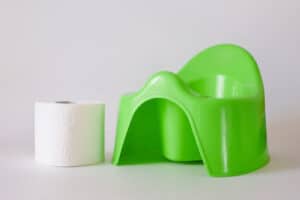
The process of potty training, or toilet learning as it is referred to in a
Toilet learning using the
The transition from diapers to using the toilet can often feel overwhelming, for all involved! If you aren’t sure where to start, or if your child is ready to start the process, then this article is for you! Read on to find out how and when to start toilet learning the
Toilet Training vs. Toilet Learning
Montessori does do potty training; however, it is referred to as toilet learning. The
Helping a child learn how to use the toilet is done through gentle guidance and by creating toilet awareness. The
How Long Does Toilet Training Take in Montessori ?
Every child is different and develops at their own pace. This means it is impossible to put a time on how long toilet learning for your child, or any child for that matter, will take. Toilet learning using the
The amount of time it takes for a child to learn how to use the toilet, therefore, depends on them. Toilet learning is a natural, gradual process that takes time.
What Age to Start Toilet Learning?
Deciding when to start potty training is often a very stressful thought process for many parents and caregivers! The
Using the
So, at what age do you start toilet learning? Children can generally control their bowel movements and bladder functions around the time they turn 1 year old.
There is debate over whether there is a sensitive period for toilet learning. Some believe the sensitive period for bringing awareness to toilet learning is between 12 and 18 months.
Toilet awareness simply means the child is aware of the toilet, how it works, what it is for, and how their body signals it is time to use the bathroom. By using cloth diapers from birth, you can bring the process of toilet awareness.
Cloth diapers allow children to feel the sensation of being wet instantly, whereas disposable diapers are designed to keep children feeling dryer for longer. Using cloth diapers helps children to become more in tune with their bodily functions and needs.
Another way to help to create toilet awareness is to talk to children about their bodily functions while changing their diapers. You can say things like “your diaper is wet because you have peed.” You must never shame your child for any of their natural bodily functions.
When is a Child Ready to Start Toilet Training in Montessori ?
So how do you know your child is ready to start toilet learning? There are several indicators that a child is ready to start toilet learning. These are:
- Walking.
- Showing interest in the toilet, such as wanting to flush the toilet.
- Wanting to take their diaper off.
- Showing an interest in cycles, for example being interested in the dirty clothes going into the laundry hamper, and into the washing machine.
- Able to dress or showing interest in dressing themselves. They should be able to pull their pants up and down easily for access to the toilet.
- They can communicate. Do they tell you when they have had a bowel movement or peed in their diaper?
- Wetting their diaper or having bowel movements at certain times of the day.
- Hiding while making a bowel movement. If your child starts to hide behind a door, under a table, or in a corner, they are seeking privacy and are ready for toilet learning.
Toddlers love to be independent, so toilet learning helps them to feel more in control of their bodies. The above are all clear indications the child in your life is ready to start toilet learning.
Montessori Toilet Learning Method
Toilet learning using the
The focus is on the child and their needs. Children should never be forced to use the potty or toilet at certain times. The best thing to do is to let your child see how you use the toilet and how you sit, wipe and wash your hands afterward.
There are three stages in toilet awareness, these are:
- Your child recognizes that they have urinated or had a bowel movement.
- Your child recognizes that they are in the process of urinating or having a bowel movement.
- Your child becomes aware that they need to use the toilet.
You can guide your child and help them to progress through each stage by changing their diaper as soon as it is wet or soiled explaining the process and showing them that wearing dry underwear/ diapers is ideal.
Prepare the Environment for Toilet Training
The first thing that is needed to begin toilet learning the
The best way to start setting up the prepared bathroom environment is by deciding if the child will be using a standalone potty or an insert for the toilet. A standalone potty is a child-sized toilet with a seat and bowl that is independent of the toilet.

An insert for the toilet seat is a toddler-sized seat, that is placed on top of the toilet.

Once you have decided whether to use a standalone potty or a toilet seat insert, the bathroom needs to be prepared for your child’s needs. This means providing the following:
- A stool: provide a stool to enable the child to reach the toilet if using a toilet seat insert. A stool should also be provided for the sink so they may wash their hands afterward.
- Toilet paper: The toilet paper should be at a level that is easy for the child to reach.
- A bucket: Provide a bucket in the bathroom for the child’s wet underwear and bottoms.
- Fresh underwear and clean clothes: Buy several pairs of underwear for your child. A basket should be placed in the bathroom with fresh underwear and a change of clothes in case your child needs to change.
- Towels/ washcloths: There should be towels or washcloths available and easily accessible in the child’s bathroom so that they can dry their hands.
- A basket of books: Include a small basket with a few books in it for the child to read while waiting to make a bowel movement on the toilet or potty.
It is important that the child has access to everything they need while in the bathroom and that they feel a sense of independence and security.

Not only is it important to prepare the bathroom environment for toilet learning, but it is also crucial to provide your child with the proper clothing. Children should wear elastic-waisted pants that are easy for them to pull up and down.
Next, Establish a Routine
Once you have prepared the environment, it is time to start the toilet learning process! This is done by incorporating using the bathroom into your routine. It is important to remember that using the toilet is a natural process that should never be forced upon a child.
You can incorporate toilet awareness into your routine before your child is ready to begin toileting by involving him or her in diaper changes. You can do this by having him or her hold the diaper and having a mobile child throw the old diaper in the trash can (laundry or disposable diaper pail).
Another great way to incorporate toilet awareness into your routine is to have your child stand up during diaper changes, so they feel more independent. You can also move the place where you change the diaper to the bathroom so that the child associates the bathroom with proper bodily functions.
When incorporating using the toilet or potty into your routine, you should avoid asking the child if they would like to use the toilet. Instead, say “it is time to use the toilet,” because nine times out of ten, the child will always say no to using the toilet.
There are several things you can do to include using the bathroom in your routine:
- Casually give the child the option to use the toilet every time you change them, when they wake up in the morning, before you leave the house, before bath, and before bed. It is important that you do not stop your child in the middle of an activity to use the toilet, or make them sit on the toilet if they do not want to.
- If your child has a bowel movement at roughly the same time each day, set a reminder to take your child to the bathroom or potty at that time.
- Let your child go diaper and bottoms-free for a few days to get used to the sensation of feeling wet after urinating.
- Look for cues that your child needs to use the bathroom, such as crossing and uncrossing legs, squatting, or touching their bottom or genitals.
- Make sure you pack a few extra outfits and underwear before you leave the house. When you leave the house, do not put underwear on your child. Instead, let them go commando (no underwear beneath their pants). The closeness of the underwear feels similar to that of a diaper. Make sure to pack bags for the wet clothes.
- Take a potty or toilet insert seat with you when you visit someone’s house to continue the routine while out.
- Incorporate washing hands after using the potty or toilet. Make sure to show them the difference between hot and cold water.
Once toilet learning has been incorporated into your routine, at some point it will be time to remove the diaper. You should remove the diaper once you see that your child’s diapers are dryer for longer periods. Going diaper free at nighttime may take longer than being diaper free during the day.
You can remove the diaper at night once your child’s diaper is dry for several consecutive nights. Remember, children often sleep too deeply to wake themselves up to use the toilet, so removing the nighttime diaper can result in wet bed sheets. It is normal and completely natural, simply change your child out of their wet clothes and replace the sheet.
Give Independence
The
Giving your child the space and freedom to be independent in the bathroom or to use the potty encourages them to want to use the toilet.
The Role of the Adult
You must support your child during the toilet learning process. If your child has a bowel movement in their pants, gently take them to the bathroom to dispose of it in the toilet and change their pants.
Your role as an adult is to be positive and kind to them while they navigate this experience. Never show disappointment or anger during toilet learning.
As the child’s parent or caregiver, your role is to offer support and to not become emotionally invested in the process. You can support your child by ensuring the bathroom is always prepared for their needs, and by guiding them through the process.
When the child doesn’t make it to the toilet in time or wets their pants, try not to refer to it as an accident as this implies they did something wrong or bad, making them feel shame for the incident. Remember, bodily functions are completely natural, they take time to control! The best thing to say in this situation is “I see you are wet, let’s change into some dry clothes.”
It is the role of the adult to be patient, calm, kind, and understanding during the process. You should guide when needed and supervise to ensure the child uses the bathroom safely.
One thing to keep in mind during toilet learning is that stressful situations or changes can cause a child to regress. Stressful situations such as a move, starting school, or a family crisis can all negatively impact a child’s toilet learning journey.
One of the most important parts of toilet learning is ensuring that you are consistent. It can be a confusing time for children, so they need you to be consistent.
There Are No Rewards in Toilet Learning
When toilet learning it is vital that you do not over-congratulate the child when they use the toilet or potty successfully. You can be positive about the child using the toilet, but do not clap or say well done for example. Using the toilet is a natural thing to do, it should be treated as such during toilet learning.
You should also not reward your child for using the potty or toilet. This is because in
How Do You Know if Toilet Learning Is Going Well?
There are several signs that toilet learning is going well. The most telling sign is a dry diaper. If a child is starting to use the toilet more, their diaper will be dryer for longer periods. Another sign that toilet learning is going well is if your child takes themselves to the potty or toilet or tells you that they need to go.
If, after some time, you say to your child “it is time to use the toilet,” and they tell you no, they do not need to, this means your child is becoming more in tune with their natural bodily functions. It is important to respect that.
Toilet learning is a process, there are no quick fixes or miracles (be wary of methods that claim otherwise). Every child will learn to use the toilet at their own pace and in their way. The
Sources:


